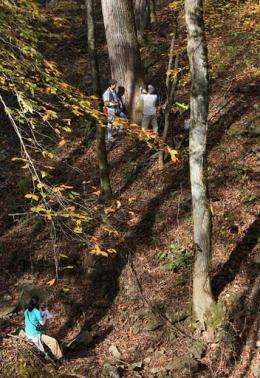Signals of past say big droughts can hit U.S. east

(�鶹��ԺOrg.com) -- Scientists examining rings from old trees spanning the last 400 years say they show that the U.S. East Coast has suffered droughts longer and more frequent than anything recorded in modern times. With large cities like New York and Atlanta struggling in recent years to maintain water supplies during dry spells, the findings suggest such cities may be in for much worse times, should such conditions return. The study was presented this week at a conference in Santa Fe, N.M., sponsored by the American Geophysical Union.
“We can handle two- to three-year droughts, but if three- and four- and five-year droughts are possible, we’re not prepared,” said Neil Pederson, a research professor with the Tree Ring Laboratory at Columbia University’s Lamont-Doherty Earth Observatory, who created the records. The familiar scene of fights and lawsuits over water is already “starting to play out here in the East,” he noted.
Pederson and his students collected cores from trees that have lived as long as 500 years, including rare old tulip poplars and hickories, as well as specimens from wooden beams in historical buildings. Because some species respond predictably by producing narrower annual rings when rainfall declines, the researchers were able to plot precipitation year by year from the 1500s on. Among other things, the cores showed three severe droughts in the 1700s in southern Appalachia that were soon followed by large die-offs of trees. The cores showed that droughts of the past 120 years—about the extent of reliable written records—have been short-lived, compared to the past ones.
Nevertheless, the recent dry spells have strained water supplies. By the middle of a 2005-2007 drought in the Southeast, Atlanta was left with only three months’ water supply, while Athens, Ga., was down to 50 days. In the last decade, New York has struggled to maintain supplies, and a 1981 drought lowered the city’s reservoirs to a third of capacity. New York has successfully reduced per capita demand for water in recent years, but Pederson says that will only partly offset the problem there. A separate 2009 study by Lamont climate modeler Richard Seager and his colleagues showed that the 2005-2007 Southeast water shortages were probably caused more by booming population and bad planning than by the relatively modest lack of rainfall. The shortages destroyed billions of dollars in crops and sparked legal battles among a half-dozen states.
Pederson says he thinks the recent shortages can be considered “human-triggered,” not the result of extraordinary weather. “These relatively minor droughts are setting off water conservation measures and draining reservoirs,” said Pederson. “That’s the scary thing.”
This spring, he and colleagues plan to sample more in Mammoth Caves National Park, Kentucky, where many trees of great age are believed to be preserved.
More information:
Provided by Columbia University



















